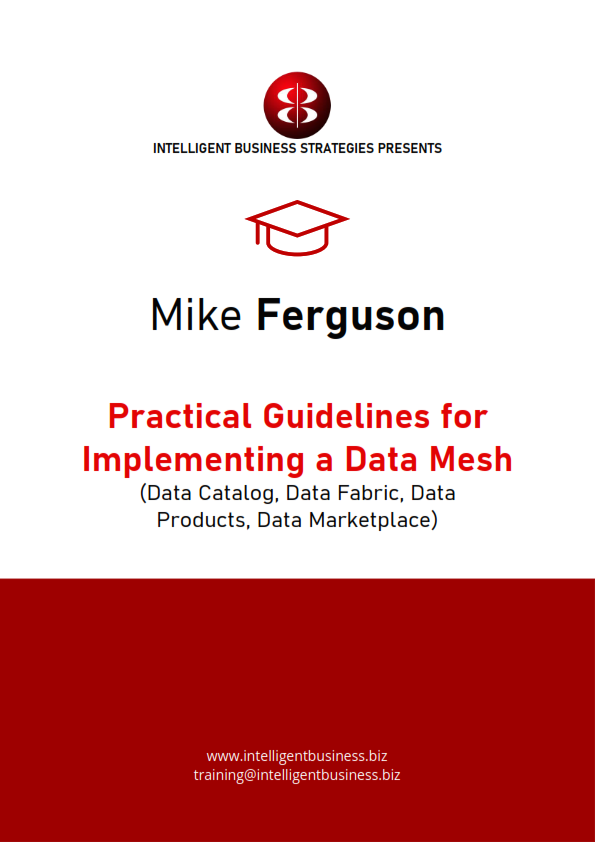
Featured Content

Data Catalogs: Governing & Provisioning Data in a Data Driven Enterprise (12 December 2024, Italy Livestream Training)

Data Strategy: Building The Foundation of a Data-Driven Enterprise (13-14 November 2024, Italy Livestream Training)

Smart Infrastructure & Smart Applications for the Smart Business – Infrastructure & Application Performance Monitoring

Data Catalogs – Governing & Provisioning Data in a Data Driven Enterprise (16 October 2024, Stockholm)
Education
Practical Guidelines for Implementing a Data Mesh

– Data Catalog, Data Fabric, Data Products, Data Marketplace
Request information on running this seminar as an Onsite (can be given as live streaming training)
Click here for the full brochure
DATES
14-15 October, 2024 – Amsterdam (Agent: Quest for Knowledge)
5-6 November, 2024 – Live Streaming Training (Agent: IRM UK)
11-12 November, 2024 – Live Streaming Training (Agent: Technology Transfer Institute)
OVERVIEW
Most companies today are storing data and running applications in a hybrid multi-cloud environment. Analytical systems tend to be centralised and siloed like data warehouses and data marts for BI, Hadoop or cloud storage data lakes for data science and stand-alone streaming analytical systems for real-time analysis. These centralised systems rely on data engineers and data scientists working within each silo to ingest data from many different sources, clean and integrate it for use in a specific analytical system or machine learning models. There are many issues with this centralised, siloed approach including multiple tools to prepare and integrate data, reinvention of data integration pipelines in each silo and centralised data engineering with poor understanding of source data unable to keep pace with business demands for new data. Also, master data is not well managed.
To address these issues, a new approach has emerged attempting to accelerate creation of data for use in multiple analytical workloads. That approach is Data Mesh. Data Mesh is a decentralised business domain-oriented approach to data ownership and data engineering to create a mesh of reusable data products that can be created once and shared across multiple analytical systems and workloads. A Data Mesh can be implemented in a number of ways. These include using one or more cloud storage accounts on cloud storage, on an organised data lake, on a Lakehouse, on a data cloud, using Kafka or using data virtualisation. Data products can then be consumed in other pipelines for use in streaming analytics, Data Warehouses or Lakehouse Gold Tables, for use in business intelligence, data science and other analytical workloads.
This 2-day class looks at data mesh in detail and examines its strengths, and weaknesses. It also looks at the strengths and weaknesses of data mesh implementation options. Which architecture is best to implement this? How do you co-ordinate multiple domain-oriented teams and use common data infrastructure software like Data Fabric to create high-quality, compliant, reusable, data products in a Data Mesh. Also, how can you use a data marketplace to share data products? The objective is to shorten time to value while also ensuring that data is correctly governed and engineered in a decentralised environment. It also looks at the organisational implications of Data Mesh and how to create sharable data products for master data management AND for use in multi-dimensional analysis on a data warehouse, data science, graph analysis and real-time streaming analytics to drive business value? Technologies discussed includes data catalogs, data fabric for collaborative development of data integration pipelines to create data products, DataOps to speed up the process, data orchestration automation, data marketplaces and data governance platforms.
AUDIENCE
This seminar is intended for business data analysts, data architects, chief data officers, master data management professionals, data scientists, IT ETL developers, and data governance professionals. It assumes you understand basic data management principles and data architecture plus a reasonable understanding of data cleansing, data integration, data catalogs, data lakes and data governance.
LEARNING OBJECTIVES
Attendees will learn about:
- Strengths and weaknesses of centralised data architectures used in analytics
- The problems caused in existing analytical systems by a hybrid, multi-cloud data landscape
- What is a data mesh and how does it differ from a data lake and a data lakehouse?
- What benefits does data mesh offer and what are the implementation options?
- What are the principles, requirements, and challenges of implementing these approaches?
- How to organise to create data products in a decentralised environment so you avoid chaos
- The critical importance of a data catalog in understanding what data is available
- How business glossaries can help ensure data products are understood and semantically linked
- An operating model for effective federated data governance
- What software is required to build, operate and govern a data mesh of data products for use in a data lake, a data lakehouse or data warehouse?
- What is data fabric software, how does it integrate with data catalogs and connect to data in your data estate
- An Implementation methodology to produce ready-made, trusted, reusable data products
- Collaborative domain-oriented development of modular and distributed DataOps pipelines to create data products
- How a data catalog and automation software can be used to generate DataOps pipelines
- Managing data quality, privacy, access security, versioning, and the lifecycle of data products
- Publishing semantically linked data products in a data marketplace for others to consume and use
- Consuming data products in an MDM system
- Consuming and assembling data products in multiple analytical systems like data warehouses, lakehouses and graph databases to shorten time to value
MODULES
- Module 1: What is data mesh and why is it needed?
- Module 2: Methodologies for creating data products
- Module 3: Using a business glossary to define data products
- Module 4: Standardising development and operations in a data mesh
- Module 5: Building DataOps pipelines to create multi-purpose data products
- Module 6: Implementing federated data governance to produce and use compliant data products






